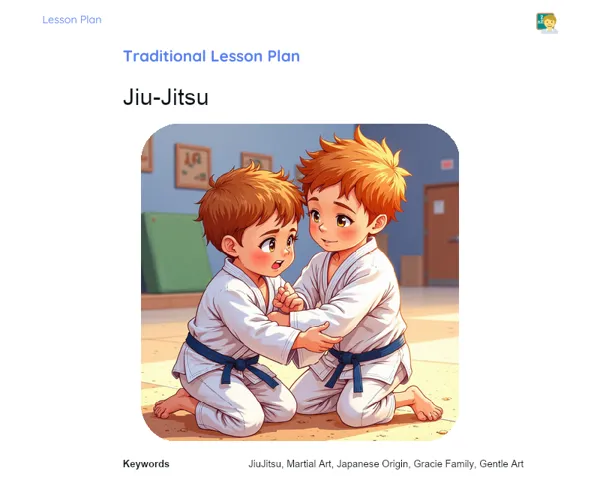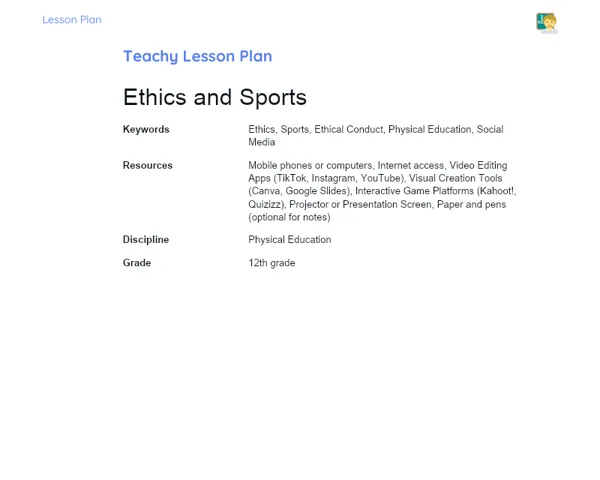Lesson Plan Teknis | Ballroom Dancing
| Palavras Chave | Ballroom Dance, Physical Education, Samba de Gafieira, Forró, Lambada, Salsa, Tango, Waltz, Hands-On Activities, Teamwork, Cultural Expression, Job Market, Coordination, Rhythm, Dance History |
| Materiais Necessários | Video of a ballroom dance performance, Spacious area for practice, Sound system, Specific music for each type of dance (samba de gafieira, forró, lambada, salsa, tango, waltz), Comfortable attire for dancing, Research materials (books, internet), Notepads and pens for taking notes |
Objective
Duration: 15 - 20 minutes
The goal of this phase is to provide students with a foundational understanding of ballroom dancing, its distinctive features, and various styles. This knowledge is vital for honing practical skills in the subsequent phases of the lesson. Furthermore, introducing the cultural backdrop and the rules of different ballroom dances equips students for better engagement with the job market, where dance can be an appreciated skill in fields such as entertainment, events management, and physical education.
Objective Utama:
1. Introduce ballroom dancing and its key features.
2. Present the basic rules and types of ballroom dance, including samba de gafieira, forró, lambada, salsa, tango, and waltz.
Objective Sampingan:
- Spark students' enthusiasm for dance as a form of fitness and cultural expression.
Introduction
Duration: 15 - 20 minutes
The intention of this phase is to equip students with a thorough and practical overview of ballroom dancing, its attributes, and its diverse styles. This foundational knowledge is crucial for the development of practical skills in the later stages of the class. Additionally, by introducing the cultural context and the rules governing different ballroom dances, students will be better prepared for opportunities in the job market, where dance can be a valuable asset.
Curiosities and Market Connection
Did you know that ballroom dancing is a treasured skill in various professional domains? In areas like entertainment and event management, for example, ballroom dancers are often sought after for performances at weddings, corporate events, and shows. Plus, ballroom dancing serves as a fantastic physical workout that enhances coordination, rhythm, and teamwork—skills highly valued across multiple professions, including physical education and wellness therapies.
Contextualization
Ballroom dance is much beyond just synchronized movements between partners. It embodies a rich tapestry of cultural heritage that has evolved over time, manifesting in different forms across the globe. From the classy ballrooms of Europe to the lively street festivities of Latin America, every style of ballroom dance narrates a tale and reflects the traditions and customs of its era and locale.
Initial Activity
Kick off the class with an engaging question: 'Did you know that some ballroom dancers travel around the world for performances at international events?' Next, share a brief video showcasing a ballroom dance performance at a major event to highlight the elegance and impact of this art.
Development
Duration: 70 - 80 minutes
The purpose of this phase is to ensure students have a robust and practical grasp of ballroom dances. By engaging in hands-on and reflective activities, they will better internalize the concepts learned and apply their new skills in real-world situations. Moreover, group practice and presentations will foster social and teamwork proficiencies, essential for both personal and professional growth.
Topics
1. Origin and history of ballroom dances
2. Characteristics and rules of major ballroom dances: samba de gafieira, forró, lambada, salsa, tango, and waltz
3. Physical and cultural advantages of practicing ballroom dances
4. Professional applications and market potential of ballroom dances
Thoughts on the Subject
Encourage students to contemplate how ballroom dance can transcend mere physical activity or recreational pastime. Ask them how they think these dances might aid in both personal and professional development and what valuable skills could be cultivated through consistent practice. Challenge them to consider real-life scenarios where ballroom dancing could offer a competitive edge or serve as a significant means of cultural expression.
Mini Challenge
Hands-On Ballroom Dance Workshop
Students will be grouped in small teams, with each group tasked to learn and present one style of ballroom dance mentioned earlier. They should conduct research, practice core steps, and create a brief choreography for their class presentation.
1. Split the class into smaller groups, assigning a specific dance style to each group: samba de gafieira, forró, lambada, salsa, tango, and waltz.
2. Each group should conduct brief research on their assigned dance, focusing on its origins, key features, and basic steps.
3. Ensure a spacious and safe area for practice.
4. Guide the groups to practice the basic steps and develop a short choreography (1-2 minutes) for presentation to the rest of the class.
5. Support the groups during practice, offering technical guidance and corrections when needed.
6. After the preparation, each group will perform their choreography for the classmates. Encourage constructive feedback from peers.
Cultivate practical dance skills, foster teamwork, and enhance understanding of the unique characteristics of each ballroom dance style.
**Duration: 40 - 50 minutes
Evaluation Exercises
1. Discuss the origin and chief characteristics of tango.
2. Explain how ballroom dance can foster physical and mental growth.
3. Name three professional sectors where ballroom dance is a treasured skill and provide reasons.
4. Describe the basic steps of forró.
Conclusion
Duration: 15 - 20 minutes
The purpose of this phase is to synthesize the topics covered, ensuring that students grasp the significance of what they have learned. By fostering reflection and discussion, students can internalize the concepts more effectively and appreciate their practical applications in personal and professional spheres. This phase also seeks to reinforce the connection between theory and practice, showcasing how the knowledge acquired can be utilized in real-world contexts.
Discussion
Encourage an open discussion with students, prompting them to reflect on the concepts covered and share their experiences during the practical workshop. Ask them about their feelings while practicing each type of ballroom dance, any challenges they encountered, and what they found most fascinating or difficult. Urge students to think about how they can apply what they learned in real situations, be it social gatherings, physical education settings, or as an additional skill in the job market. Encourage dialogue about how dance can contribute to personal and professional development and what essential skills were acquired, such as coordination, rhythm, teamwork, and cultural understanding.
Summary
Recap the key content discussed during the lesson, emphasizing the variety and cultural depth of ballroom dances. Remind students of the different styles covered, including samba de gafieira, forró, lambada, salsa, tango, and waltz, highlighting their main traits and rules. Stress the importance of practice and how every dance has a unique narrative and specific movements.
Closing
Clarify how the class intertwined theory and practice, aiding students in understanding not just the steps and techniques of ballroom dancing but also how they relate to cultural and professional settings. Emphasize the role of practical learning and its potential as a competitive advantage in job pursuits. Conclude by underscoring the significance of the subject in everyday life, whether as a physical activity fostering well-being, a means of cultural expression, or a valuable professional asset in numerous fields.


